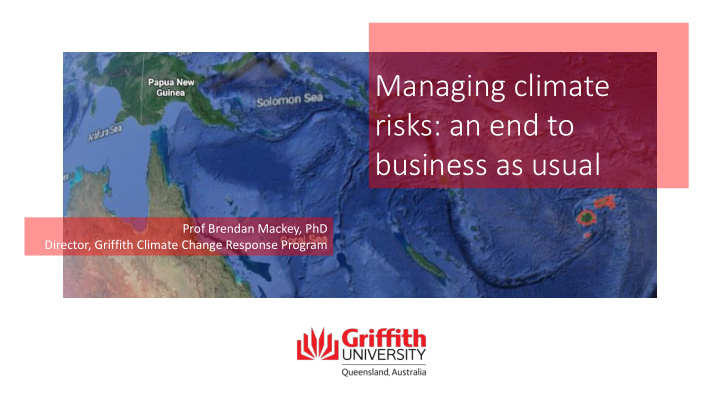



Managing climate risks: an end to business as usual Prof Brendan Mackey, PhD Director, Griffith Climate Change Response Program
IPCC Special Reports
Ocean: Projected future impacts • Marine heatwaves and extreme El Niño and La Niña events are projected to become more frequent. Climate models project increases in the frequency of marine heatwaves by 2081 – 2100, relative to 1850 – 1900, by approximately 50 times under RCP8.5 • Sea level continues to rise at an increasing rate. Extreme sea level events that are historically rare (once per century in the recent past) are projected to occur frequently (at least once per year) at many locations by 2050 in all RCP scenarios, especially in tropical regions • Extreme sea levels and coastal hazards will be exacerbated by projected increases in tropical cyclone intensity and precipitation • A decrease in global biomass of marine animal communities, their production, and fisheries catch potential, and a shift in species composition are projected over the 21st century in ocean ecosystems. The rate and magnitude of decline are projected to be highest in the tropics
Massive impacts for tropical shallow coral reefs Beyond adaptation… If the current warming rate continues, the world would reach human-induced global warming of 1.5°C around 2040 Coral reefs are projected to decline by a further 70 – 90% at 1.5 o C (high confidence) with larger losses (>99%) at 2 o C (very high confidence) Sources: IPCC 1.5 Degree Special Report Deloitte Access Economics 2017 Image: Great Barrier Reef Foundation
Types of assets and objectives at climate risk • Risks to assets arising from capital works • Risks to ecosystem services & benefits • Risks to community health and wellbeing • Risk to agricultural productivity and profitability • Financial risks • Risks from “stranded policies” (policy pathway dependencies) • Risks to service delivery & program implementation
Climate risks disrupt conventional risk assessment Risk from 4 ° C global warming (~2100? Risk from 2 ° C global warming (~2080?) Risk from 1.5 ° C global warming (~2040) Risk from 1 ° C global warming (current)
What should business do? • Climate change brings both risks and opportunities for businesses • Mitigation regulatory frameworks are set to increase in scale and scope with the general trend being to put a price on carbon • Reputational value will increasingly become linked to demonstrating ‘climate responsible’ operations • Climate change-related impacts are projected to intensify in the coming decades and these impacts directly and indirectly affect commercial operations, with the entire value chain potentially implicated • But where there is change there is also opportunity, and the private sector will provide the engine that drives and delivers the necessary innovations
You need a business plan for climate change Each enterprise needs a business plan for climate change that includes consideration of five components: 1. A carbon and energy audit and mitigation strategy 2. A risk assessment and adaptation strategy 3. Evaluation of emerging climate change-related business opportunities 4. A review of regulatory frameworks and policy engagement, and 5. Public relations and communications.
But, the world community must mitigate CO 2 emissions • As global warming increases, so does the likelihood of irreversible impacts, loss and damage • For many things we value, the risks are existential and the impacts catastrophic • Business has a key leadership role to play in building the groundswell for ambitious, urgent climate action Source: ABC News
Recommend
More recommend